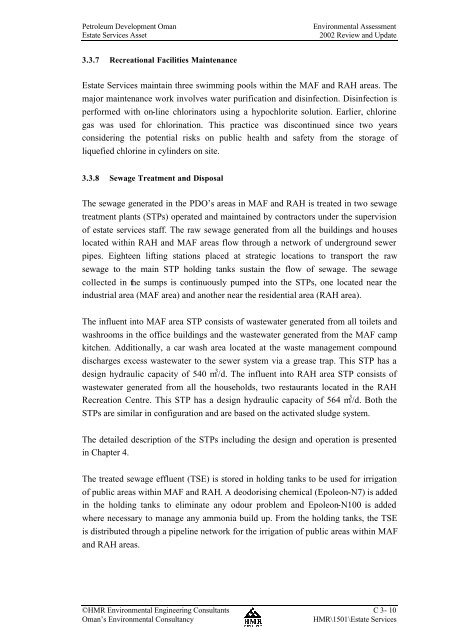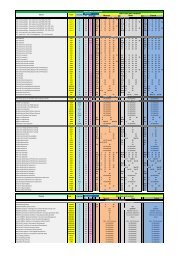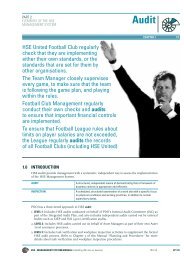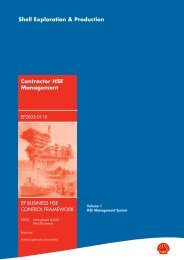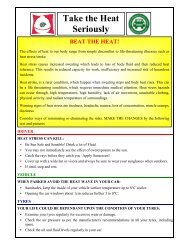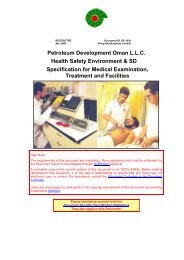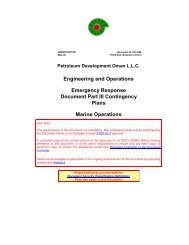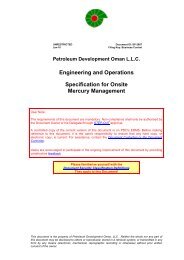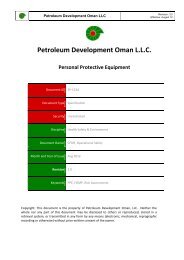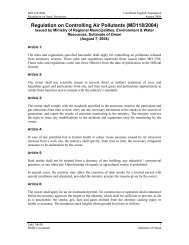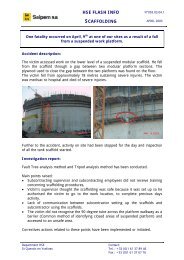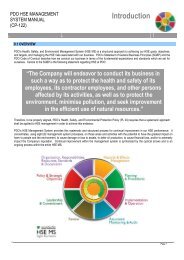Estate Service Asset - PDO
Estate Service Asset - PDO
Estate Service Asset - PDO
You also want an ePaper? Increase the reach of your titles
YUMPU automatically turns print PDFs into web optimized ePapers that Google loves.
Petroleum Development Oman<br />
<strong>Estate</strong> <strong>Service</strong>s <strong>Asset</strong><br />
Environmental Assessment<br />
2002 Review and Update<br />
3.3.7 Recreational Facilities Maintenance<br />
<strong>Estate</strong> <strong>Service</strong>s maintain three swimming pools within the MAF and RAH areas. The<br />
major maintenance work involves water purification and disinfection. Disinfection is<br />
performed with on-line chlorinators using a hypochlorite solution. Earlier, chlorine<br />
gas was used for chlorination. This practice was discontinued since two years<br />
considering the potential risks on public health and safety from the storage of<br />
liquefied chlorine in cylinders on site.<br />
3.3.8 Sewage Treatment and Disposal<br />
The sewage generated in the <strong>PDO</strong>’s areas in MAF and RAH is treated in two sewage<br />
treatment plants (STPs) operated and maintained by contractors under the supervision<br />
of estate services staff. The raw sewage generated from all the buildings and houses<br />
located within RAH and MAF areas flow through a network of underground sewer<br />
pipes. Eighteen lifting stations placed at strategic locations to transport the raw<br />
sewage to the main STP holding tanks sustain the flow of sewage. The sewage<br />
collected in the sumps is continuously pumped into the STPs, one located near the<br />
industrial area (MAF area) and another near the residential area (RAH area).<br />
The influent into MAF area STP consists of wastewater generated from all toilets and<br />
washrooms in the office buildings and the wastewater generated from the MAF camp<br />
kitchen. Additionally, a car wash area located at the waste management compound<br />
discharges excess wastewater to the sewer system via a grease trap. This STP has a<br />
design hydraulic capacity of 540 m 3 /d. The influent into RAH area STP consists of<br />
wastewater generated from all the households, two restaurants located in the RAH<br />
Recreation Centre. This STP has a design hydraulic capacity of 564 m 3 /d. Both the<br />
STPs are similar in configuration and are based on the activated sludge system.<br />
The detailed description of the STPs including the design and operation is presented<br />
in Chapter 4.<br />
The treated sewage effluent (TSE) is stored in holding tanks to be used for irrigation<br />
of public areas within MAF and RAH. A deodorising chemical (Epoleon-N7) is added<br />
in the holding tanks to eliminate any odour problem and Epoleon-N100 is added<br />
where necessary to manage any ammonia build up. From the holding tanks, the TSE<br />
is distributed through a pipeline network for the irrigation of public areas within MAF<br />
and RAH areas.<br />
©HMR Environmental Engineering Consultants C 3- 10<br />
Oman’s Environmental Consultancy<br />
HMR\1501\<strong>Estate</strong> <strong>Service</strong>s


